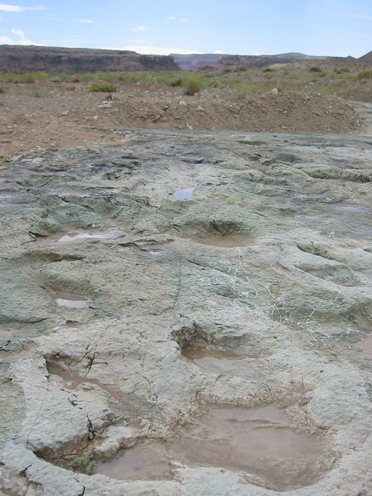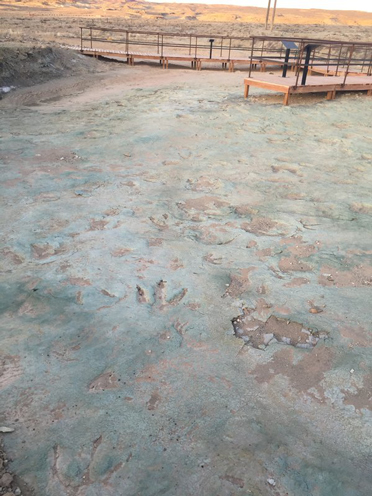An Important Update – Assessment Reports “Minor” Damage to Mill Canyon Track Site
An assessment of the Mill Canyon dinosaur track site north of Moab in Grand County, Utah by Bureau of Land Management regional palaeontologist Brent Breithaupt confirms that damage was caused to the Early Cretaceous tracks and trace fossils by a construction crew, but the damage is described as “minor”.

Trace fossils (dinosaur footprints) preserved at Moab (Utah). Picture credit: Bureau of Land Management.
Picture credit: Bureau of Land Management
Essential Repairs and Maintenance at an Important Fossil Site
The site, which covers approximately 2.3 acres contains over 200 tracks and other trace fossils recording activity around a body of water at an Early Cretaceous lake (approximately 112 million years ago). A construction crew had been employed to undertake repairs and improvements to the site including the replacement of boardwalks. Members of the public became aware of the maintenance work and reported possible damage to the fossils caused by the construction crew.
Everything Dinosaur published a blog article on reports of the damage caused by Bureau of Land Management contractors: Dinosaur Tracksite Damaged and having had concerns raised about damage to the site, it was decided to conduct an assessment of the area in order to find the best way to protect the fossils whilst still permitting public access.
This Damage to the Track Site Should Not Have Occurred
The assessment concluded that the overall damage was minor. Even so, Brent Breithaupt wrote in the report that:
“This damage should not have occurred”.
The regional palaeontologist added, that if the project had not been stopped:
“It is likely that much greater damage would have occurred with increased construction activities”.
As the Bureau of Land Management failed to consult palaeontologists on the maintenance plans, crews did not know which areas of the site to avoid. The incident was described in the report as “unfortunate” and the damage “could have been avoided”.

At least six different dinosaur tracks have been deciphered at Moab (Utah). Picture credit: Bureau of Land Management.
After the report was released, the Bureau of Land Management has confirmed that an additional environmental assessment would be undertaken, the public would be consulted and palaeontologists involved in future work at the location to supervise activities. The Bureau of Land Management reported that it “remains committed to protecting plant and animal fossils on our public lands”.
The Everything Dinosaur website: Dinosaur Toys.

